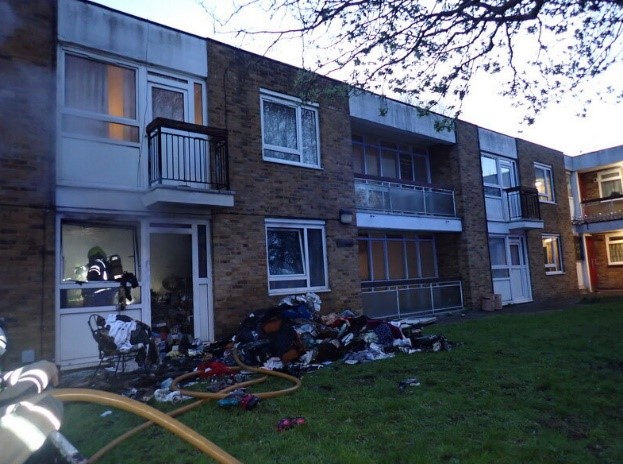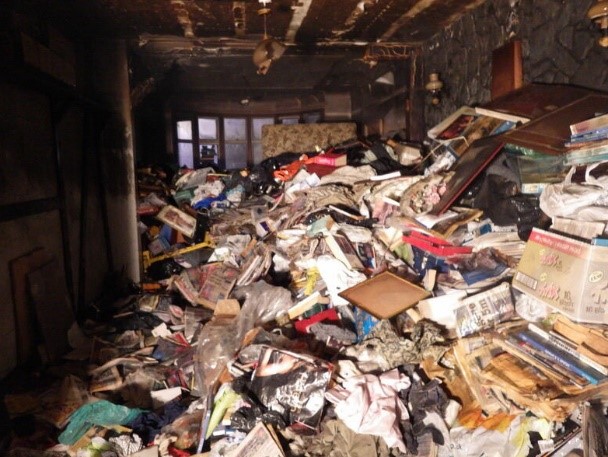London Fire Brigade is urging those who store large amounts of possessions at home to reach out for support over concerns the cost-of-living crisis could exacerbate the risk of devastating fires.
Last year, London Fire Brigade attended almost 1,040 hoarding-related fires, with around 186 injuries and sadly, 10 deaths. In a bid to help those with hoarding tendencies, the Brigade is highlighting the support they offer and are asking people who hoard possessions, or who know someone who does, to complete the Home Fire Safety Checker.
It’s not uncommon for people to acquire an excessive number of items and find it difficult to throw things away, but hoarding means exit routes can become blocked, making escape more difficult in the event of a fire. Fires can also spread much faster and difficult access can make these types of fires dangerous for crews.
The Brigade is particularly concerned that with the increased cost of living, those with hoarding tendencies are even more at risk as they look for alternative, cost-effective ways to cook, as well as heat and light their homes.
Last month, eight fire engines and around 60 firefighters tackled a flat fire in Lewisham, where a large amount of possessions were stored. Thirteen adults and two children were led to safety by firefighters wearing breathing apparatus and a woman was taken to hospital. The property was left un-inhabitable following the blaze. The Brigade’s fire investigators believe the fire was caused by a portable heater placed too close to stored items in the flat.

Station Officer Samual Redfern said: “We’re starting to see alternative methods being used for cooking, heating and lighting due to the rising cost of living. There’s always a fire risk when people use candles, portable stoves or portable heaters at home, but the risk is heightened for those with hoarding tendencies.
“For example, I’ve seen a number of people using portable heaters and their rooms are filled floor to ceiling with possessions. There needs to be sufficient space around heaters in order to use them safely, but when you don’t have that space and items are just so close to the heaters, the fire risk is really heightened. The same goes with cooking in a kitchen with possessions right next to the hob.
“There are so many people with hoarding tendencies that we don’t know about, which is one of our biggest concerns. We are working with social care teams to identify people with hoarding tendencies in order to get them the care and help they need and are asking people to reach out to us for help by completing our Home Fire Safety Checker.”
The Brigade takes a person-centred approach to hoarding and works with local communities to catch hoarding tendencies early. Hoarding behaviour is usually brought to their attention through Home Fire Safety Visits, when attending incidents, working with partners like the council, or through referrals. In 2022, LFB received more than 1,600 hoarding referrals.
The Brigade can offer a wide range of support for those with hoarding tendencies including: providing specific safety advice, ensuring there is adequate smoke and fire detection in the property, referring people to partner agencies, visiting properties regularly and putting plans in place to help reduce the behaviour.

Speaking about a harrowing experience of tackling a fire at a property where occupants were hoarding possessions, Station Commander Daniel Pearson said: “When there are a lot of stored possessions in a property, it takes much longer for us to tackle fires because we have to clear out rooms.
“In one fire I attended, the house was nearly impossible to gain entry to. It was an older gentleman, and he was completely devastated that his personal belongings were damaged by the fire. There are far more risks for us too because of the trip hazards and the heightened risk of building collapse as possessions soak up water.
“Our firefighters are going into incredibly difficult environments to navigate and it’s a challenge to get fire crews out safely.”
Station Officer Redfern said: “An incident that really stands out for me is a fire I attended early on in my career. It was an elderly lady and she had everything from toys to newspapers piled high in her home.
“As we got through the door, we had to crawl through a really small space to get into the property. It took us around 30 or 40 minutes to get safe access to the building. Everything was alight. Sadly, she died.”
Borough Commander Richard Tapp said: “I’ve been to houses where it’s only the hallway where they can physically put a smoke alarm. It’s difficult because there is no quick fix, but if we can do something, whether that’s put up smoke alarms, give advice or clear an escape route, then every little helps.
“This is where identifying those who may have hoarding tendencies is important, because this is a gradual process and there are still risks that will remain after we have been. That way, if we need to attend a fire at the building, our crews know what they’re going into and can work to mitigate the risks."
The Brigade’s Community Engagement Team also work closely with Hoarding UK and have a representation from Hoarding UK on their community forum which helps them better understand the needs of people with hoarding behaviour.
The Brigade’s Home Fire Safety Checker will guide users around their home to identify fire risks and provide tailored advice to help mitigate them. The checker will also signpost people to book an in-person visit if they are at high risk.